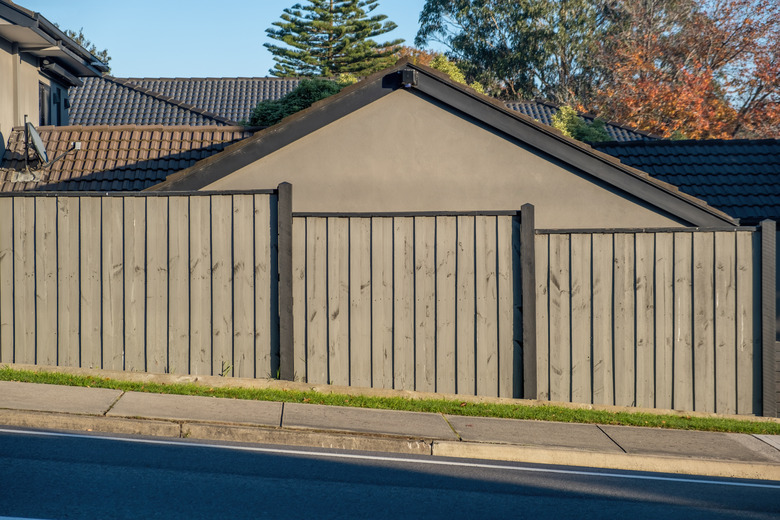How To Install A Fence On Unlevel Ground
We may receive a commission on purchases made from links.
A fence has three components: posts, rails, and the fencing itself, which may be pickets, slats, panels, chain-link mesh, or something else. When you build a fence on level ground, the rails are perpendicular to the posts, and the fencing is parallel to the posts. You can use this design on undulating ground by setting the bottom rail above the highest point and using pickets of different lengths to fill in the gaps. Alternatively, you can use any type of fencing of uniform length and fill in the gaps with something else or just leave them as they are.
On a steady slope, the fence has to follow the lay of the land, and you have a couple of options for doing this. One is to sacrifice perpendicularity and set the rails at an angle relative to the slope. The other is to construct the fence in stepped sections with rails perpendicular to the posts but with each section installed at a lower elevation as the fence proceeds downhill. There are pros and cons to each method.
Installing a Stepped Fence
Installing a Stepped Fence
If you choose the stepped method, you'll set the fence posts straight just as you would when constructing a fence on level ground, spacing them more or less the same distance, although they might have to be closer if the ground is really steep. The rails extend perpendicularly between the posts, but because the elevation decreases, the rails intersect each lower post farther from the ground than on the adjacent post on higher ground. This creates a rectangular frame on which to hang the slats, pickets, or fencing panels.
The main problem with this method is that it creates a large gap under the fencing on the side of each post that faces the adjacent one on higher ground. You can reduce this gap by spacing the posts closer together, but if you're trying to keep animals in or out of your yard, you usually have to fill it in with more fencing, wire mesh, or something else.
Installing a Standard Racked Fence
Installing a Standard Racked Fence
A racked fence is one that follows the slope of the ground. To build one, you set the posts level and space them as you would on level ground, and you install the rails at an angle to make them more or less parallel to the ground. When you install the slats or pickets, you make them perpendicular to the posts and arrange them to make the tops follow the same line as the rails. The result is that the top of the fence slopes with the ground.
One problem with this method is that it won't work with prefabricated fencing panels, which are rectangular and can't be modified to have angles. Another problem is that the rails have to be cut with precise angles to match the slope of the ground, which can change along the length of the fence. Doing this accurately is a chore that takes skill and practice.
Chain-Link Fences
Chain-Link Fences
When installing a chain-link fence on sloping ground, you use the racking method. You set the posts upright and space them as you would on level ground, and you install the rails to follow the slope of the ground. This is easy to do because the connectors that hold the rails to the posts can pivot.
When you install the mesh, you follow the line created by the top and bottom rail. Stretch the mesh for the length of the fence and let it overlap the corner posts by several inches on the short end, letting the long end overlap by whatever extra distance is created by the slope. Use wire snippers to cut the ends parallel to the posts and then attach the mesh to the posts with tension bars and clamps.
